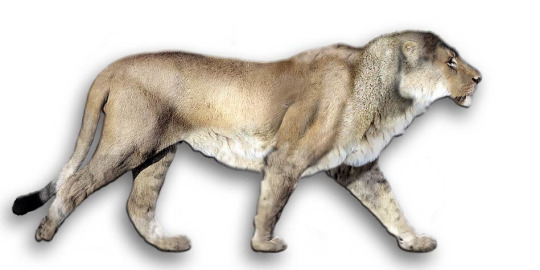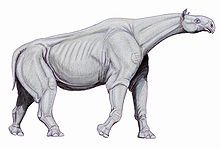Text
European cave lion (Panthera leo spelaea)

Des: A lion that lived up to 13,000 years ago that lived in the caves of Eurasia. It is theorised that they evolved less than 600,000 years ago with the oldest known fossils being dated to being around 62,400 years old. They grew up to sizes of 362 kg with them standing at least 1.2m at the shoulder, this is much bigger than a male African lions 190 kg and it is estimated that cave lions were around 10% larger than the largest African lions. Fossils and other remains have frequently been found in caves with some instances alongside cave bears suggesting they preyed on each other or at least each others young. An interesting find was some remains of fur and analysis found that they were similar in colour to modern day though slightly paler.
Pros: European. If bring back cave bear need to have the other type of cave animal. It's a big ass kitty. Cooler (and bigger) than a normal lion.
Cons: Already have one big cat on here which is more well known and popular (smilodon). a cave to call home.
Overall?: Yes
#cave lion#European cave lion#panthera leo spelaea#panthera spelaea#prehistoric cat#prehistoric#prehistoric big cat
4 notes
·
View notes
Text
Hornless rhino (Paraceratherium)

Des: This was a herbivorous rhino that lived during the Oligocene from 34 to 23 million years ago and grazed throughout Eurasia. It is debatably the biggest mammal to have ever lived depending on how big you estimate paraceratherium was as the elephant palaeoloxodon namadicus may have been slightly bigger. It has been estimated that to its shoulder it was 4.8 metres tall and weighed anything from 15-20 tonnes, the skull alone of these things were 1.3 metres long. They lived in dry, arid habitats and grazed on the leaves of the trees that grew there.
Pros: Cool looking giraffe rhino. Bigger than an elephant.
Cons: Needs a lot of food. Also existed way too long ago to find suitable DNA. Just plain bizarre looking. Waaaaaaaayyyyy too big (like nearly 5 metres tall).
Overall?: No.
1 note
·
View note
Text
Terror birds (Phorusrhacidae) aka Nope birds

Des: Giant ass bird that reached up to 3m tall, that all apart from one species (Titanis walleri) lived in south America and lived up to 17,000 years ago. Carnivorous (evidence in curved end in beak which is the same as other modern day birds of prey). Kelenken guillermoi was the largest which lived in Argentina 15 million years ago in the miocene and its skull alone was 70cm (28 inches) long.
Pros: Giant murder bird.
Cons: Giant murder bird.
Overall?: No.
7 notes
·
View notes
Text
Sabre-toothed cat (S. populator)

Des: Lived in south America up to 10,000 years ago and was the largest out of the smilodons weighing up to 470 kg (the biggest tigers are only 306 kg in comparison). Three types of smilodon: populator was the biggest then had fatalis and gracilis. The species are named after and well known for their elongated canines which in s.populator were 28cm or 11 inches long though whilst looked impressive they were fragile and could have easily been broken. The short stocky build suggests they were specialised ambush predators and were often capable of taking down the large megaherbivores of the north American plains.
Pros: Lots of research into them and modern day cats so ruff idea of how to deal with them. Not as dangerous as a velociraptor. The kittens! Could have either S.gracilis instead or Megantereon (preferably megantereon as it has my name in it).
Cons: Dem teeth though. Bigger than any modern day cat. Could easily eat me.
Overall?: Yes.
3 notes
·
View notes
Text
Cave bear (Ursus spelaeus)

Des: Big ass bear that died out 24,000 years ago and lived in Europe especially in the caves (no shit sherlock). The largest males grew up to 600 kg and were more or less the same size as modern polar bears .They were omnivores that ate both meat and vegetable matter (as evident from teeth structure).
Pros: Finally see what they looked like. A brown bear the size of a polar bear. Could ride
them into battle. Cubs are cute. Just overall a really badass animal. It is also found in western europe
Cons: Scary.
Overall?: Yes.
1 note
·
View note
Text
Woolly mammoth (Mammuthus primigenius)

Description: You know what it is. If not it is a descendent of the steppe mammoth and the males could reach heights of up to 3.4 metres to the shoulder. Its mainland range became extinct at the end of the pleistocene 10,000 years ago however some isolated island populations survived up to 4,000 years ago on Wrangel island (near Siberia).
Pros: Easily the coolest and one of my favorite on the list. Relatively easy to maintain if kept in the right kind of environment (e.g grassy planes (right spelling? idk) Siberia). They look bad to the ass!
Cons: Need to be in a herd as very social and family orientated creatures (if they are indeed like modern day elephants). Need a lot of space.
Overall?: Yes.
2 notes
·
View notes